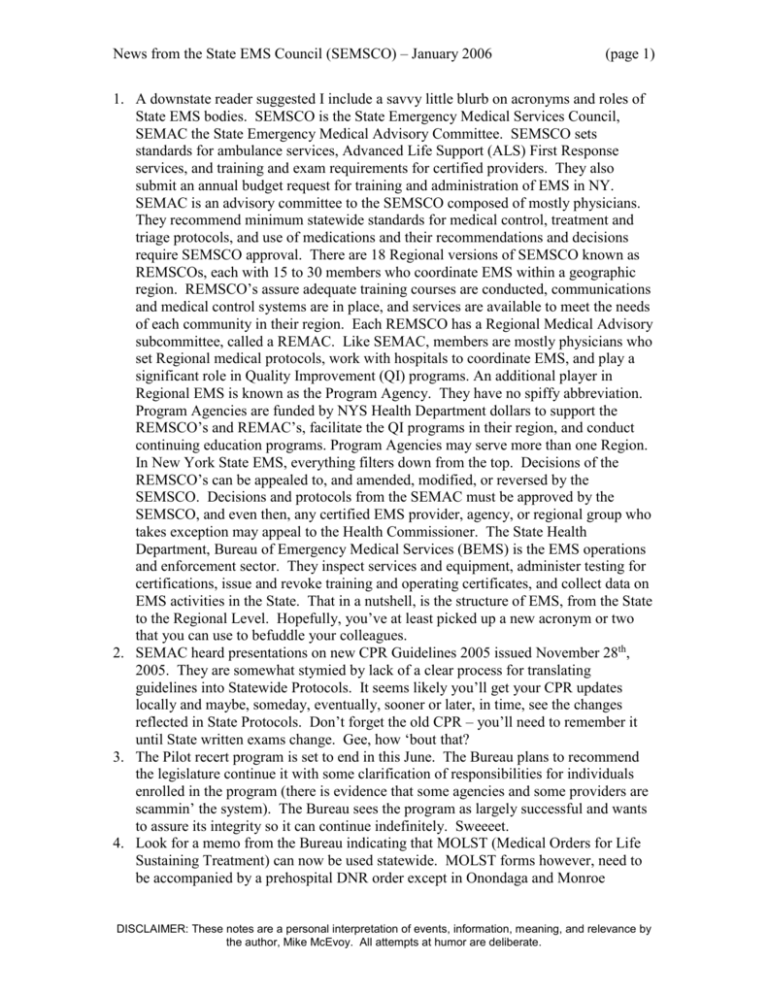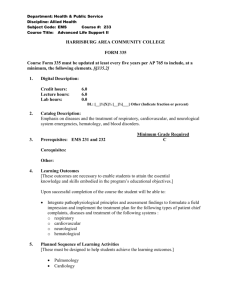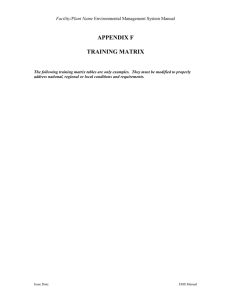Jan 2006 - Saratoga County EMS Council
advertisement

News from the State EMS Council (SEMSCO) – January 2006 (page 1) 1. A downstate reader suggested I include a savvy little blurb on acronyms and roles of State EMS bodies. SEMSCO is the State Emergency Medical Services Council, SEMAC the State Emergency Medical Advisory Committee. SEMSCO sets standards for ambulance services, Advanced Life Support (ALS) First Response services, and training and exam requirements for certified providers. They also submit an annual budget request for training and administration of EMS in NY. SEMAC is an advisory committee to the SEMSCO composed of mostly physicians. They recommend minimum statewide standards for medical control, treatment and triage protocols, and use of medications and their recommendations and decisions require SEMSCO approval. There are 18 Regional versions of SEMSCO known as REMSCOs, each with 15 to 30 members who coordinate EMS within a geographic region. REMSCO’s assure adequate training courses are conducted, communications and medical control systems are in place, and services are available to meet the needs of each community in their region. Each REMSCO has a Regional Medical Advisory subcommittee, called a REMAC. Like SEMAC, members are mostly physicians who set Regional medical protocols, work with hospitals to coordinate EMS, and play a significant role in Quality Improvement (QI) programs. An additional player in Regional EMS is known as the Program Agency. They have no spiffy abbreviation. Program Agencies are funded by NYS Health Department dollars to support the REMSCO’s and REMAC’s, facilitate the QI programs in their region, and conduct continuing education programs. Program Agencies may serve more than one Region. In New York State EMS, everything filters down from the top. Decisions of the REMSCO’s can be appealed to, and amended, modified, or reversed by the SEMSCO. Decisions and protocols from the SEMAC must be approved by the SEMSCO, and even then, any certified EMS provider, agency, or regional group who takes exception may appeal to the Health Commissioner. The State Health Department, Bureau of Emergency Medical Services (BEMS) is the EMS operations and enforcement sector. They inspect services and equipment, administer testing for certifications, issue and revoke training and operating certificates, and collect data on EMS activities in the State. That in a nutshell, is the structure of EMS, from the State to the Regional Level. Hopefully, you’ve at least picked up a new acronym or two that you can use to befuddle your colleagues. 2. SEMAC heard presentations on new CPR Guidelines 2005 issued November 28th, 2005. They are somewhat stymied by lack of a clear process for translating guidelines into Statewide Protocols. It seems likely you’ll get your CPR updates locally and maybe, someday, eventually, sooner or later, in time, see the changes reflected in State Protocols. Don’t forget the old CPR – you’ll need to remember it until State written exams change. Gee, how ‘bout that? 3. The Pilot recert program is set to end in this June. The Bureau plans to recommend the legislature continue it with some clarification of responsibilities for individuals enrolled in the program (there is evidence that some agencies and some providers are scammin’ the system). The Bureau sees the program as largely successful and wants to assure its integrity so it can continue indefinitely. Sweeeet. 4. Look for a memo from the Bureau indicating that MOLST (Medical Orders for Life Sustaining Treatment) can now be used statewide. MOLST forms however, need to be accompanied by a prehospital DNR order except in Onondaga and Monroe DISCLAIMER: These notes are a personal interpretation of events, information, meaning, and relevance by the author, Mike McEvoy. All attempts at humor are deliberate. News from the State EMS Council (SEMSCO) – January 2006 (page 2) counties where a legislatively authorized trial of the MOLST forms is in progress. The devil is in the details however, as MOLST is far more comprehensive than the present paperwork. Honoring any advanced directive beyond “No CPR” would probably require consultation with medical control. Oh well, at least MOLST provides a standard format for patients to make their wishes known. 5. Here’s a get outta jail free card: make note that out-of-state ALS students interning in NYS programs must have a valid NYS EMT card. Reciprocity is readily available through NYS DOH; most course sponsors are well aware of this. Ya think? 6. If you’ve ever been stymied by internet research leading you smack into fee-based periodical web sites, help is here. Residents of NYS with a valid driver’s license or non-driver id can access the New York Online Virtual Electronic Library (NOVEL) with full text access to thousands of national and international newspapers, magazines, business and investment information, photos, maps, graphics, and educational materials. NYS picks up the subscription costs using a Federal Grant awarded to the NYS Library. Point your browser to www.novelnewyork.org and have at it. 7. CHEMPACK is no longer top secret. A recent series of workshops for County Officials around the State reflects a change of tune on CHEMPACK deployment. Bottom line: there’s a CHEMPACK accessible to every EMS service in New York State designed to rapidly deploy nerve agent antidotes if needed. Unless local officials teach field providers how to access CHEMPACK resources, it’ll never be requested or deployed when the Real McCoy hits. Stay tuned… 8. You might recall earlier mention of a deal that would provide burn kits for every ambulance in NYS courtesy of the State Hospital Preparedness people. Well, it’s comin’, but no ETA yet. 9. Vital Signs 2006 will be October 20 through 22 in Syracuse. Scope it out at www.vitalsignsconference.com . 10. If you were hoping to grab your partner and do-si-do to celebrate the completed spinal immobilization protocol, you’re outta luck. The process derailed when it was realized that the protocol as presently drafted would exponentially increase field immobilization of patients, sorta diabolically opposite of the original intent. More work will happen at the March meeting. Yeah right. 11. “Disadvantaged Signal Area,” that’s some new lingo from the folks at SWN (Statewide Wireless Network). In their annual report to the State, SWN says they plan to complete wireless coverage by December 2006 in their “primary region” which includes Erie and Cayuga Counties. They’ll finish the rest of the State by September 18, 2010. Maybe the Spinal Immobilization protocol will be done by then, too. 12. Dates are pretty well set for a 3-hour EMS Child Abuse and Neglect con-ed program in 5 locations during February 2006. Details should be available on your Regional Program agency website. If not, the program will run in Buffalo on Saturday, February 4; in Albany on Saturday, February 11; in New Hampton on Saturday, February 18; in Syracuse on Saturday, February 25; and somewhere in NYC and/or Long Island TBA. Preregistration is required either through your Regional Program Agency or by calling the EMSC (EMS for Children) program at 518-402-0996, ext. 1, 4. DISCLAIMER: These notes are a personal interpretation of events, information, meaning, and relevance by the author, Mike McEvoy. All attempts at humor are deliberate. News from the State EMS Council (SEMSCO) – January 2006 (page 3) 13. Still no word on the Suffolk County dispatch crew confirmation and mutual aid protocol appeal or the appeal of a New York City REMAC decision to allow reduction of FDNY ALS FR unit staffing from 2 medics to an EMT and single medic. Both appeals were upheld by SEMAC and have been further appealed to the Commissioner. Expect a decision sometime in March 2006. 14. SEMSCO previously tabled a SEMAC motion that EMT-Basics be trained to acquire 12-lead EKGs (if approved by their Region and Service Medical Director). The thought was to obtain input the various SEMSCO Committees on potential impact and implementation issues. Now SEMAC has trouble recalling what the motion was, SEMSCO Committees spent hours debating the potential impact and, you guessed it – nothing happened. Expect a lot more talk and no action anytime soon. 15. The PIER committee is gearing up to run a little contest at Vital Signs 2006. They’d like to design a statewide universal EMS logo with hopes of featuring it on an EMS pin somewhere down the road. Put your thinking cap on and bring your ideas to Vital Signs in the ‘Cuse this October. 16. The Systems Committee revealed their almost final draft of a new CON (Certificate of Need) policy statement. Debate now seems to hedge on the archaic definition of “public need” held over in the policy from prior versions (93-09 and 93-10). No doubt, the “public need” definition needs reworking but given that most CON appeals tend to center around administrative process (not definition of need), many feel that the draft should be issued and the “need” piece tackled later. Battle lines may be forming, or maybe not. Stay tuned. 17. Keep your eye out for a new policy statement # 06-01 scheduled to appear any month now on the DOH website at www.health.state.ny.us “Emergency Patient Destinations and Hospital Diversion.” It delineates EMS responsibility to transport patients to specialty centers, and clarifies hospital diversion requests. 18. 2006 SEMAC and SEMSCO meetings have been finalized for March 7 and 8, May 23 and 24, September 14 and 15, and December 12 and 13. The March meetings are planned for Saratoga Springs. These notes respectfully prepared by Mike McEvoy, PhD, RN, CCRN, REMT-P who was the 2005 Chair of the State EMS Council where he represents the NYS Association of Fire Chiefs. Mike remains on the Council as a wise old past-chair, kinda like an old Fire Chief. Mike is EMS Coordinator for Saratoga County, a paramedic for Clifton ParkHalfmoon Ambulance Corps, a firefighter and chief medical officer for West Crescent Fire Department. At Albany Medical Center, Mike works as a clinical specialist in the Cardiac Surgical ICUs, Chairs the Resuscitation Committee, and teaches pulmonary and critical care medicine at Albany Medical College. Contact Mike at McEvoyMike@aol.com. If you want a personal copy of these “unofficial” SEMSCO minutes delivered directly to your email account, surf to the Saratoga County EMS Council at www.saratogaems.org and click on the “NYS EMS News” tab (at the top of the page). There, you’ll find a list server dedicated exclusively to circulating these notes. Past copies of NYS EMS News are posted there as well. DISCLAIMER: These notes are a personal interpretation of events, information, meaning, and relevance by the author, Mike McEvoy. All attempts at humor are deliberate.






